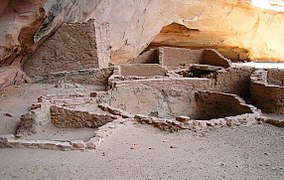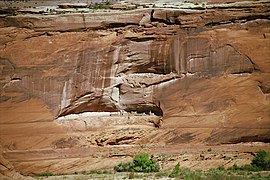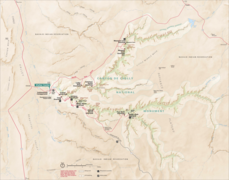Canyon De Chelly National Monument
Canyon de Chelly National Monument (/dəˈʃeɪ/ də-SHAY) was established on April 1, 1931, as a unit of the National Park Service.
Located in northeastern Arizona, it is within the boundaries of the Navajo Nation and lies in the Four Corners region. Reflecting one of the longest continuously inhabited landscapes of North America, it preserves ruins of the indigenous tribes that lived in the area, from the Ancestral Puebloans (also known as the Anasazi) to the Navajo. The monument covers 83,840 acres (131 sq mi; 339 km2) and encompasses the floors and rims of the three major canyons: de Chelly, del Muerto, and Monument. These canyons were cut by streams with headwaters in the Chuska Mountains just to the east of the monument. None of the land is federally owned. Canyon de Chelly is one of the most visited national monuments in the United States.
| Canyon de Chelly National Monument | |
|---|---|
 Canyon de Chelly, 1904, by Edward S. Curtis | |
| Location | Apache County, Arizona |
| Nearest city | Chinle |
| Coordinates | 36°09′19″N 109°30′32″W / 36.155281°N 109.508995°W |
| Area | 83,840 acres (339.3 km2) |
| Created | April 1, 1931 |
| Visitors | 439,306 (in 2018) |
| Governing body | Bureau of Indian Affairs |
| Website | Canyon de Chelly National Monument |
| NRHP reference No. | 70000066 |
| Added to NRHP | August 25, 1970 |
Etymology
The name Chelly is a Spanish borrowing of the Navajo word Tséyiʼ (or Tsegi), which means "rock canyon" (literally "inside the rock" < tsé "rock" + -yiʼ "inside of, within"). The Navajo pronunciation is [tséɣiʔ]. The Spanish pronunciation of de Chelly [deˈtʃeʎi] was adapted into English, apparently modeled on [clarification needed] a French-like spelling pronunciation, and is now /dəˈʃeɪ/ də-SHAY.
History
Canyon de Chelly is thought to have been sporadically occupied by Hopi Indians from circa 1300 to the early 1700s, when the Navajo then moved into the canyon from places in northern New Mexico. From that time forward it has served as a home for Navajo people before it was invaded by forces led by future New Mexico governor Lt. Antonio Narbona in 1805, during which time 115 Navajos were slain and 33 taken captive. In 1863, Col. Kit Carson sent troops through the canyon, killing 23 Navajo, seizing 200 sheep, and destroying hogans, as well as peach orchards and other crops. The resulting demoralization led to the surrender of the Navajos and their removal to Bosque Redondo, New Mexico.
Description
Canyon de Chelly is entirely owned by the Navajo Tribal Trust of the Navajo Nation. It is the only National Park Service unit that is owned and cooperatively managed in this manner. About 40 Navajo families live in the park. Access to the canyon floor is restricted, and visitors are allowed to travel in the canyons only when accompanied by a park ranger or an authorized Navajo guide. The only exception to this rule is the White House Ruin Trail, however this trail has been closed until further notice since March 2020.

The park's distinctive geologic feature, Spider Rock, is a sandstone spire that rises 750 feet (230 m) from the canyon floor at the junction of Canyon de Chelly and Monument Canyon. Spider Rock can be seen from South Rim Drive. It has served as the scene of a number of television commercials. According to traditional Navajo beliefs, the taller of the two spires is the home of Spider Grandmother.
Most park visitors arrive by automobile and view Canyon de Chelly from the rim, following both North Rim Drive and South Rim Drive. Ancient ruins and geologic structures are visible, but in the distance, from turnoffs on each of these routes. Deep within the park is Mummy Cave. It features structures that have been built at various times in history. Private Navajo-owned companies offer tours of the canyon floor by horseback, hiking or four-wheel drive vehicle. The companies can be contacted directly for prices and arrangements. No entrance fee is charged to enter the park, apart from any charges imposed by tour companies.
Accommodations for visitors are located in the vicinity of the canyon, on the road leading to Chinle, which is the nearest town.
The National Monument was listed on the National Register of Historic Places on August 25, 1970.
Climate
According to the Köppen Climate Classification system, Canyon de Chelly has a cold semi-arid climate, abbreviated "BSk" on climate maps. The hottest temperature recorded in Canyon de Chelly was 105 °F (40.6 °C) on July 2, 2002, July 14, 2003, and June 21, 2016, while the coldest temperature recorded was −32 °F (−35.6 °C) on January 2, 1919.
| Climate data for Canyon de Chelly, Arizona, 1991–2020 normals, extremes 1908–present | |||||||||||||
|---|---|---|---|---|---|---|---|---|---|---|---|---|---|
| Month | Jan | Feb | Mar | Apr | May | Jun | Jul | Aug | Sep | Oct | Nov | Dec | Year |
| Record high °F (°C) | 70 (21) | 72 (22) | 85 (29) | 90 (32) | 101 (38) | 105 (41) | 105 (41) | 102 (39) | 99 (37) | 90 (32) | 79 (26) | 69 (21) | 105 (41) |
| Mean maximum °F (°C) | 57.3 (14.1) | 64.1 (17.8) | 74.6 (23.7) | 82.6 (28.1) | 91.3 (32.9) | 99.4 (37.4) | 100.9 (38.3) | 96.9 (36.1) | 92.4 (33.6) | 83.4 (28.6) | 69.8 (21.0) | 58.8 (14.9) | 101.5 (38.6) |
| Mean daily maximum °F (°C) | 43.8 (6.6) | 50.6 (10.3) | 60.7 (15.9) | 68.9 (20.5) | 79.0 (26.1) | 90.0 (32.2) | 92.9 (33.8) | 89.7 (32.1) | 82.7 (28.2) | 69.9 (21.1) | 55.5 (13.1) | 43.3 (6.3) | 68.9 (20.5) |
| Daily mean °F (°C) | 31.4 (−0.3) | 37.1 (2.8) | 45.0 (7.2) | 52.4 (11.3) | 61.4 (16.3) | 71.3 (21.8) | 76.5 (24.7) | 74.2 (23.4) | 66.2 (19.0) | 53.7 (12.1) | 41.0 (5.0) | 31.4 (−0.3) | 53.5 (11.9) |
| Mean daily minimum °F (°C) | 19.0 (−7.2) | 23.6 (−4.7) | 29.2 (−1.6) | 35.8 (2.1) | 43.7 (6.5) | 52.5 (11.4) | 60.2 (15.7) | 58.8 (14.9) | 49.8 (9.9) | 37.5 (3.1) | 26.5 (−3.1) | 19.6 (−6.9) | 38.0 (3.3) |
| Mean minimum °F (°C) | 5.2 (−14.9) | 10.3 (−12.1) | 17.1 (−8.3) | 22.9 (−5.1) | 31.3 (−0.4) | 40.1 (4.5) | 51.9 (11.1) | 51.4 (10.8) | 36.1 (2.3) | 24.2 (−4.3) | 12.1 (−11.1) | 5.0 (−15.0) | 1.2 (−17.1) |
| Record low °F (°C) | −32 (−36) | −22 (−30) | 1 (−17) | 9 (−13) | 10 (−12) | 20 (−7) | 38 (3) | 38 (3) | 23 (−5) | 10 (−12) | −3 (−19) | −27 (−33) | −32 (−36) |
| Average precipitation inches (mm) | 0.76 (19) | 0.73 (19) | 0.65 (17) | 0.48 (12) | 0.51 (13) | 0.27 (6.9) | 1.07 (27) | 1.30 (33) | 0.85 (22) | 0.83 (21) | 0.58 (15) | 0.72 (18) | 8.75 (222.9) |
| Average snowfall inches (cm) | 1.1 (2.8) | 0.9 (2.3) | 0.6 (1.5) | 0.1 (0.25) | 0.0 (0.0) | 0.0 (0.0) | 0.0 (0.0) | 0.0 (0.0) | 0.0 (0.0) | 0.1 (0.25) | 0.6 (1.5) | 1.5 (3.8) | 4.9 (12.4) |
| Average precipitation days (≥ 0.01 in) | 4.4 | 4.7 | 4.1 | 3.1 | 2.8 | 1.7 | 6.3 | 6.9 | 5.2 | 4.1 | 3.5 | 4.8 | 51.6 |
| Average snowy days (≥ 0.1 in) | 0.8 | 0.7 | 0.7 | 0.1 | 0.0 | 0.0 | 0.0 | 0.0 | 0.0 | 0.1 | 0.4 | 1.0 | 3.8 |
| Source 1: NOAA | |||||||||||||
| Source 2: National Weather Service | |||||||||||||
Gallery
- White House Ruin
- Antelope House Ruin
- Massacre Cave
- Snow at the canyon, with Mummy Cave in the background
- First Ruin
- White House Ruin, Timothy H. O'Sullivan, 1873
- Park map
See also
References
- Official website
- "Canyon de Chelly National Monument". Geology Fieldnotes. National Park Service. Archived from the original on June 13, 2011. Retrieved June 29, 2011.
- Historic American Buildings Survey (HABS) No. AZ-157, "Antelope House Ruin, Canyon del Muerto, Chinle vicinity, Apache County, AZ"
- HABS No. AZ-213, "Bad Trail Ruin, Chinle vicinity, Apache County, AZ"
- HABS No. AZ-211, "Ledge Ruin, Canyon del Muerto, Chinle vicinity, Apache County, AZ"
- HABS No. AZ-72, "Mummy Cave, Navajo Indian Reservation, Chinle vicinity, Apache County, AZ"
- HABS No. AZ-156, "White House Ruin, Navajo Indian Reservation, Chinle vicinity, Apache County, AZ"
- HABS No. AZ-212, "Yucca House Ruin, Canyon del Muerto, Chinle vicinity, Apache County, AZ"
- Canyon de Chelly (poem by Simon Ortiz, 1977) Accessed 2013 January 15
This article uses material from the Wikipedia English article Canyon de Chelly National Monument, which is released under the Creative Commons Attribution-ShareAlike 3.0 license ("CC BY-SA 3.0"); additional terms may apply (view authors). Content is available under CC BY-SA 4.0 unless otherwise noted. Images, videos and audio are available under their respective licenses.
®Wikipedia is a registered trademark of the Wiki Foundation, Inc. Wiki English (DUHOCTRUNGQUOC.VN) is an independent company and has no affiliation with Wiki Foundation.










